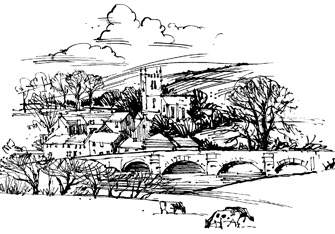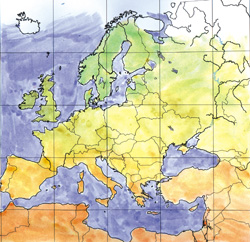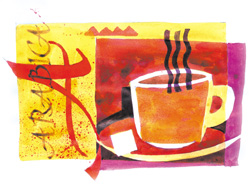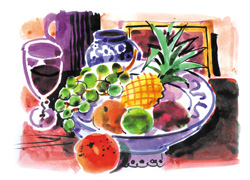Drawing Inks
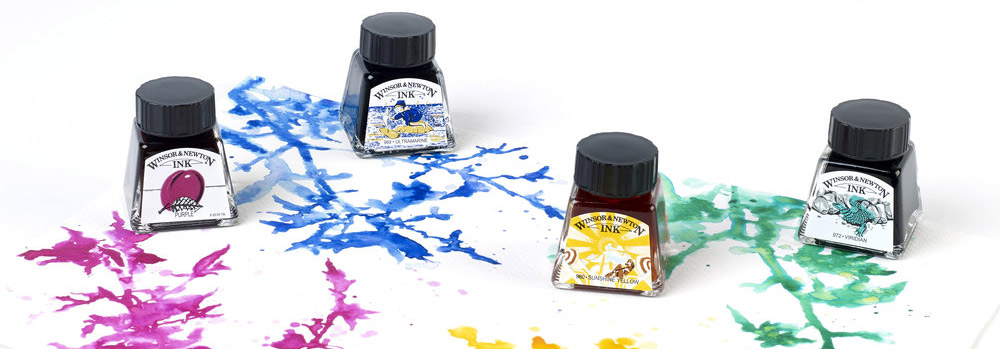
Winsor & Newton Drawing Inks have been used by illustrators since their introduction in the 1890's, where the main requirement is brilliance of colour.
Today they are formulated from a series of soluble dyes in a superior shellac solution. These inks can be applied with brush, dip pen or airbrush and are widely used by designers, calligraphers and artists as well as illustrators.
Colour Range
The range comprises 26 colours including Liquid Indian Ink, a water based solution of traditional Chinese stick ink. This is the standard lettering ink used by calligraphers (which is not water resistant).
Sizes Available
The full range of 26 Drawing Ink colours are available in 14ml bottles, each with their own uniquely designed box. Blacks, Gold and Silver are available in 30ml bottles. Black Indian Ink (the 'spider' design) is available in 30ml with a dropper lid and 250ml & 500ml bottles.
Drawing Ink Properties
Brilliant Colours
With over 170 years of colour making expertise Winsor and Newton offer a range of inks with superior strength and brilliance of colour.
Infinite Optical Colour Mixes
Fast drying, water resistant & transparent, this allows the overlaying of different colours for attractive optical colour mixtures. All the colours are water resistant except Liquid Indian Ink, Gold and Silver.
Fully Intermixable
All the colours are intermixable. Gold and Silver should be added to other inks in small quantities to avoid thickening. Mixtures of Gold and Silver together should not be stored due to adverse chemical reaction.
Easily Diluted
The colours can be easily diluted with water to reduce the strength of the colour or to increase its transparency. Distilled water must be used as tap water causes the dye to separate from the binder.
The following illustrations show some of the different types of applications and styles that can be used with Drawing inks:
|
|
|
|
Permanence
As Drawing Inks contain dyes, they do not possess the lightfast properties of pigmented colours and should not be used in work which is intended for display in lighted areas. This does not apply to Blacks and White which are pigmented and Gold and Silver which are metal based. Although metallic colours are lightfast they may show tarnishing in the long term.
Pens for Drawing Inks
Drawing Inks can be used with dip pens for writing but are not recommended for airbrushing or fountain pens as the binder clogs the nozzle or nib respectively. They can be used with both the Gillot Mapping Pen and the Gillot Drawing Pen.
Brushes for use with Drawing Inks
There are a multitude of brushes on the market, and choosing the right one can be daunting. All water colour brushes can be used with Inks but there are some brushes in particular which we would recommend.
Artists' Water Colour Sable Brushes
Sceptre Gold II Brushes
Cotman Brushes
These brushes are recommended due to their good colour carrying capacity, ability to point, spring back into shape and reasonable price. Care should be taken to rinse the brushes in water whilst working to prevent the ink from drying hard into the hair.
In such cases, methylated spirits can be used to dissolve the colour, followed by thorough washing with soap and warm water.
Surfaces for Drawing Inks
Paper or Illustration board is the most commonly used surface for Drawing Inks. As a general rule, the paper surface needs to be smooth to allow the pen to move over it quickly. Winsor & Newton Smooth Surface Drawing Pads and any Hot Pressed water colour papers are ideal. Hot pressed water colour paper provides a smooth surface which prevents cockling. See our wide selection of water colour papers.
A soft paper or a rougher surface may have a tendency to fluff causing the nib or tip of the pen to catch, especially when a quick stroke is made. A paper both internally and externally surface-sized is also recommended as this will help to prevent bleeding and add to colour brilliance.
Drawing inks are also used on acetate films for overlaying by designers. Due to the many types available, acetates should be tested first to ensure the ink will be accepted.
Next to paper, illustration board is the most commonly used support by designers' using Drawing Inks. Winsor & Newton Extra Smooth Surface Bristol Board is excellent for this use. Drawing Inks are also used on acetate films for overlaying by designers. Due to the many types available, acetates should be tested first to ensure the ink with be accepted.











